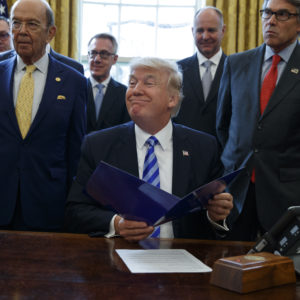On Wednesday, backed by a crowd of smiling members of the International Union of Operating Engineers, President Donald Trump signed two executive orders expediting the approval process for new pipelines and energy infrastructure. For the industry, the orders were a sign that the president continues to make energy a top priority, while environmentalists are likely to challenge them in court. But the orders could make a key difference in four stymied pipeline projects across the country.
These pipelines–the Constitution pipeline in New York, the Keystone XL pipeline near Canada, Enbridge Line 3 in Minnesota, and Enbridge Line 5 in Michigan–have been the subject of sustained controversy. In each case, states have taken action to block or impede the construction of pipelines that have received federal approval.
The Constitution pipeline, which would run 124 miles from Susquehanna County, PA, to an interconnect in Schoharie County, NY was clearly on the president’s mind during the signing.
“In New York, they’re paying tremendous amounts of money more for energy to heat their homes because New York State blocked a permit to build the Constitution Pipeline,” Trump said.
“This obstruction does not just hurt families and workers like you; it undermines our independence and national security. The two executive orders that I’ll be signing in just a moment will fix this, dramatically accelerating energy infrastructure approvals. So we’re going to get these approvals done quickly,” he continued.
Federal and state regulators have been sparring over the future of the pipeline for years. In 2014, the Federal Energy Regulatory Committee (FERC) issued its final environmental impact statement and a certificate allowing construction of the pipeline to begin. According to FERC, under the plan proposed by the pipeline’s builders, environmental impacts from the pipeline would be “less than significant.”
The state of New York disagrees. In 2016, the New York Department of Environmental Conservation denied the project a water quality certification. Since then, the project has been tied up in court, as the two sides debate whether the state or federal agency has final approval authority. The issue is further complicated by the fact that New York did not act on the water quality certification within the one-year timeline specified by the federal Clean Water Act.
Trump’s executive order calls on the Environmental Protection Agency to update its interpretations of the Clean Water Act to restrict state action.
This will also help the stalled Enbridge Line 3 project which would replace an aging pipeline between Edmonton, Alberta and Superior, Wisconsin. The Line 3 project runs through parts of North Dakota, Minnesota, and Wisconsin, but has encountered resistance from Minnesota regulators.
In June, the state’s Public Utilities Commission held heated hearings in St. Paul to discuss approval of the pipeline. Crowds filled the commission’s meeting room and protesters floated down the Mississippi in kayaks to oppose the project. Last month, the commission approved the project for the third time.
That hasn’t been enough for Minnesota Gov. Tim Walz (D), who said in early April that his administration had renewed its challenge to the pipeline yet again, further delaying a project that has already been permitted and completed in Wisconsin.
A similar situation is playing out in Michigan with a different Enbridge pipeline. Enbridge Line 5 is a 66-year-old pipeline carrying oil from western Canada to eastern Canada via the Great Lakes states. Its most controversial section passes underneath the Straits of Mackinac, connecting Lake Huron and Lake Michigan.
As in Minnesota, Enbridge is looking to replace the aging pipe and the idea is controversial to say the least. Last December, the Michigan legislature approved the Great Lakes Pipeline Project, a massive infrastructure plan to create a tunnel underneath the straits. Line 5 would be one of two pre-existing pipelines moved to run through the tunnel.
This plan was approved by then-Michigan Gov. Rick Snyder (R) and the state legislature, which approved the plan in the final days of their last session. When Democrat Gretchen Whitmer took office at the start of 2019, one of her first actions as governor was to halt the project, asking the state attorney general to look into whether the approval process was constitutional. At the end of March, on the basis of the attorney general’s opinion, she further ordered the suspension of all work on the project, a move that may be challenged in court.
The final pipeline on President Trump’s mind was likely the Keystone XL pipeline. More than two years ago, Trump officially issued a presidential permit for the long-debated, perennially controversial project. At the time, he spoke warmly about how TransCanada would “finally be allowed to complete this long overdue project with efficiency and speed.”
That hasn’t happened.
Instead, approval for the pipeline has been tied up in court. At the beginning of April, environmental groups sued in federal court in Montana, arguing that Trump lacked the authority to issue permits because Congress administers federal lands.
President Trump’s executive orders will make it easier for infrastructure projects to get approval, but many battles still lie ahead.

